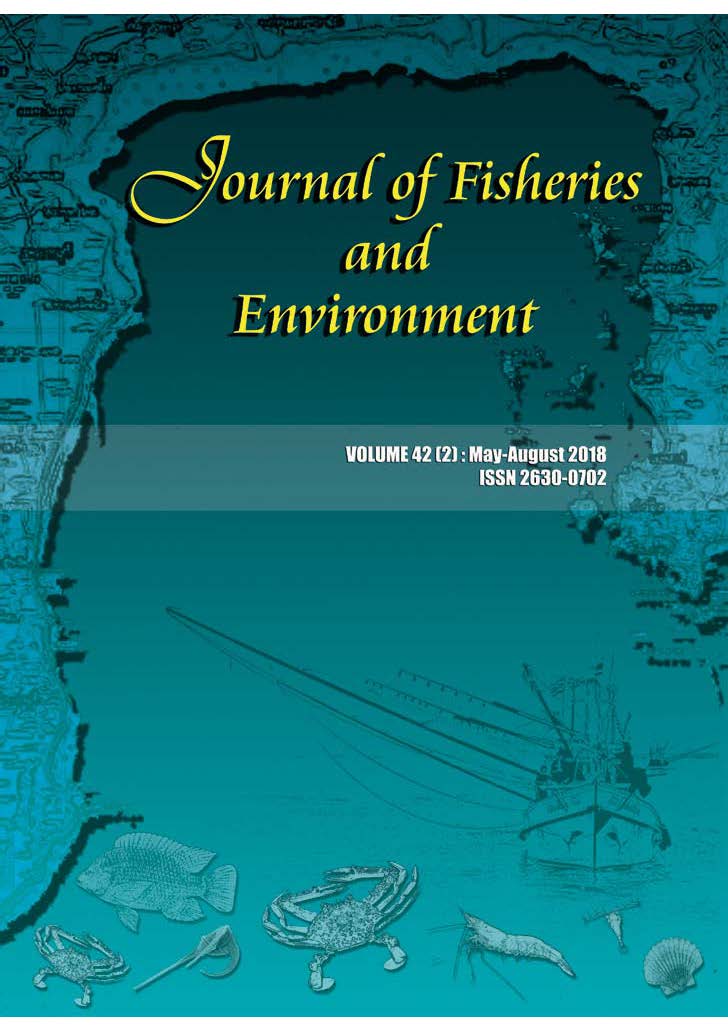Photosynthetic Response of Gracilaria fisheri (Xia & Abbott) Abbott, Zhang & Xia to Irradiance, Temperature and Salinity Variation
Main Article Content
Abstract
The red seaweed Gracilaria fisheri has been used for human food, for marine animal feeding, and for agar extraction. This algal species is extensively cultured, but its production is often unpredictable due to lack of basic biological information on this species. This work aims to determine the effects of irradiance, salinity and temperature on the photosynthesis of this species. Plants were subjected to different irradiance (0–1150 µmol photons.m-2.s-1), salinity (15–40‰), and temperature (12–40°C) levels in a growth chamber. Photosynthesis was determined using a dissolved oxygen sensor and pulse amplitude-modulated fluorometry. The results showed rapid light curves increasing with irradiance up to 1150 μmol photons.m-2.s-1. The highest Pnet was obtained at 203 µmol photons.m-2.s-1, temperature 24oC and a salinity of 30‰, which also corresponded to the highest maximum quantum yield. Our study revealed that the Pnet rates were highest from 24–28°C at an irradiance of 203 µmol photons.m-2.s-1 and was lower at higher and lower temperatures.
Article Details
References
2. Araujo, F.O., S. Ursi and E.M. Plastino. 2014. Intraspecific variation in Gracilaria caudata
(Gracilariales, Rhodophyta): growth, pigment content, and photosynthesis. Journal of
Applied Phycology 26: 849–858.
3. Chirapart, A. and K. Lewmanomont. 2004. Growth and production of Thai agarophyte cultured in natural pond using the effluent seawater from shrimp culture. Hydrobiologia 512: 117–126.
4. Chirapart, A., J. Munkit and K. Lewmanomont. 2006. Changes in yield and quality of agar from the agarophytes, Gracilaria fisheri and G. tenuistipitata var. liui cultivated in earthen ponds. Kasetsart Journal (Natural Science) 40: 529–540.
5. Choi, H.G., Y.S. Kim, J.H. Kim, S.J. Lee, E.J. Park, J. Ryu and K.W. Nam. 2006. Effects of temperature and salinity on the growth of Gracilaria verrucosa and G. chorda, with the potential for mariculture in Korea. Journal of Applied Phycology 18: 269–277.
6. Eggert, A. 2012. Seaweed responses to Temperature. In: Seaweed Biology: Novel Insights into Ecophysiology, Ecology and Utilization (eds. W. Christian and K. Bischof), pp. 47–66. Springer International Publishing AG Springer Heidelberg New York Dordrdrecht London.
7. Fujimoto, M., G.N. Nishihara, A. Prathep and R. Terada. 2015. The effect of irradiance and temperature on the photosynthesis of an agarophyte, Gelidiella acerosa (Gelidiales, Rhodophyta), from Krabi, Thailand. Journal of Applied Phycology 27: 1235–1242.
8. Jayasankar, R. 2005. Effect of salinity on physiology of Gracilaria spp. (Gigartinales,
Rhodophyta). Seaweed Research and Utilization 27: 19–24.
9. Kumar, M., P. Kumari, C.R.K. Reddy and B. Jha. 2014. Chapter Four - Salinity and Desiccation Induced Oxidative Stress Acclimation in Seaweeds. In: Advances in Botanical Research, Sea plants, Vol. 71 (ed. N. Bourgougnon), pp. 91–123. Elsevier, UK.
10. Lewmanomont, K. 1994. The species of Gracilaria from Thailand. In: Taxonomy of economic seaweeds, Vol.4 (eds. I.A. Abbott), pp. 135–148. La Jolla, California Sea Grant College Program, U.S.A.
11. Lobban, C.S. and P.J. Harrison. 1994. Seaweed Ecology and Physiology. Cambridge University Press, London. 366 pp.
12. Lu, C.M. and J.H. Zhang. 1999. Effects of salt stress on PSII function and photoinhibition in the cyanobacterium Spirulina platensis. Journal of Plant Physiology 155: 740–745.
13. Murata, N., S. Takahashi, Y. Nishiyama and S.I. Allakhverdiev. 2007. Photoinhibition of photosystem II under environmental stress. Biochimica et Biophysica Acta 1767: 414–421.
14. Nguyen, P.T., R. Ruangchuay and C. Lueangthuwapranit. 2017. Effect of shading colours on
growth and pigment content of Gracilaria fisheri (Xia & Abbott) Abbott, Zhang & Xia
(Gracilariales, Rhodophyta). Aquaculture Research 48: 1119–1130.
15. Ohno, M., R. Terada and H. Yamamoto. 1999. The species of Gracilaria from Vietnam. In:
Taxonomy of Economic Seaweeds with reference to some Pacific species, Vol. VII (eds. I.A. Abbott), pp. 99–111. La Jolla, California, California Sea Grant College System.
16. Phang, S-M, H.-Y. Yeong, E.T. Ganzon-Fortes, K. Lewmanomont, A. Prathep, L.N. Hau,
G.S. Gerung and K.S. Tan. 2016. Marine algae of the South China Sea bordered by
Indonesia, Malaysia, Philippines, Singapore, Thailand and Vietnam. Raffles Bulletin
of Zoology (Supplement) 34: 13–59.
17. Phooprong, S., H. Ogawa and K. Hayashizaki. 2007. Photosynthetic and respiratory responses
of Gracilaria salicornia (C. Ag.) Dawson (Gracilariales, Rhodophyta) from Thailand
and Japan. Journal of Applied Phycology 19: 795–801.
18. Phooprong, S., H. Ogawa and K. Hayashizaki. 2008. Photosynthetic and respiratory responses of
Gracilaria vermiculophylla (Ohmi) Papenfuss collected from Kumamoto, Shizuoka and
Iwate, Japan. Journal of Applied Phycology 20: 293–300.
19. Porra, R.J., W.A. Thompson and P.E. Kriedemann. 1989. Determination of accurate extinction
coeficients and simultaneous for assaying chlorophylls a and b extracted with four
different solvents: verification of the concentration of chlorophyll standards by atomic
absorption spectroscopy. Biochimica et Biophysica Acta 975: 384–394.
20. Ruangchuay, R., C. Lueangthuvapranit and M. Nuchikaew. 2010. Cultivation of Gracilaria fisheri
(Xia & Abbott) Abbott, Zhang & Xia (Gracilariales, Rhodophyta) in abandoned shrimp
ponds along the coast of Pattani Bay, southern Thailand. Algal Resources 3: 185–192.
21. Terada, R., T.D. Vo, G.N. Nishihara, K. Shioya, S. Shimada and S. Kawaguchi. 2016. The effect of irradiance and temperature on the photosynthesis and growth of a cultivated red alga Kappaphycus alvarezii (Solieriaceae) from Vietnam, based on in situ and in vitro measurements. Journal of Applied Phycology 28: 457–467.
22. Tseng, C.K. 2001. Algal biotechnology industries and research activities in China.
Journal of Applied Phycology 13: 375–380.
23. Xu, Y., W. Wei and J. Fang. 2009. Effects of salinity, light and temperature on growth rates of two species of Gracilaria (Rhodophyta). Chinese Journal of Oceanology and Limnology 27: 350–355.

